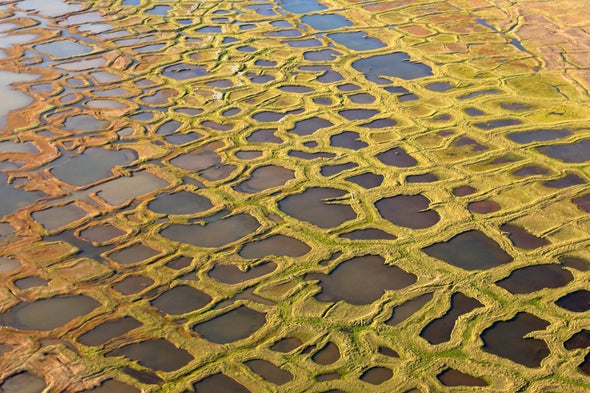As Arctic permafrost thaws, it unleashes a vicious cycle—the unfrozen soil releases its carbon reserves that intensify climate change, in turn accelerating the thaw. Now researchers have reported another disturbing discovery: The permafrost holds a much greater cache of mercury than thought—and as the ground warms, it could potentially release that toxic metal on the world.
In the new study, published this week in Geophysical Research Letters, an international team of scientists drilled 13 permafrost soil cores at various locations in Alaska. Back at their lab they analyzed the frozen cores to measure factors such as moisture, organic carbon and mercury content. The 50- to 100-centimeter cores spanned a time between 22,000 and 2,400 years ago, meaning the vast majority of mercury they hold came from nonhuman sources. The researchers used their measurements to extrapolate an estimate of how much mercury is stored in the entire Northern Hemisphere’s permafrost.
Their results indicate Arctic permafrost holds about 793 gigagrams of mercury—more than 15 million gallons, or the equivalent of about 23 Olympic swimming pools, says Paul Schuster, a research geologist for the U.S. Geological Survey and one of the study authors. When the researchers calculated the amount of mercury likely stored in both the permafrost and the layer of soil that sits above it (and routinely thaws for part of the year), they estimated there is a total of 1,656 gigagrams. “The active layer and the permafrost together contain nearly twice as much [mercury] as all the other soils, the ocean and the atmosphere combined,” the researchers wrote in their study.
Permafrost is frozen soil, rock or sediment that stays at or below freezing for at least two consecutive years. It covers about a quarter of the Northern Hemisphere’s landmass, which helps explain why it holds so much mercury. But permafrost is also unique in that its frozen state traps the mercury in the soil, rather than allowing it to be mobile in the environment. “In [other locations such as] the Lower 48 [U.S. states], soils are hydrologically connected and mercury cycles through. It’s part of the whole global mercury cycle,” Schuster says. “In the Arctic you’re locking in the mercury—it’s not reacting with the rest of the world.”
The new findings have potentially massive implications for ecosystems and human health. Between 30 and 99 percent of the Arctic’s near-surface permafrost is predicted to thaw by 2100, according to the study. As it does so, at least a portion of the previously locked-away mercury will probably become mobile. “It becomes not just an Arctic problem, but a global problem,” says Elsie Sunderland, an associate professor of environmental science and engineering at Harvard University who was not involved in the study. “It doesn’t just say in the [same] place.”
The mercury could either be washed into the Arctic Ocean and then circulate through the global marine system or escape into the atmosphere and travel to other parts of the planet. Either in the Arctic soil or in the broader environment, mercury can get converted into a form dangerous to humans and other wildlife, including marine animals. “The other half of the story—the one that most people are concerned with—is how does this affect the health of our environment, our aquatic systems, us?” Schuster says. “This has major ramifications.”
Other experts concur: “It really reinforces the [idea] that climate change can make a lot of other environmental issues worse,” says Noelle Selin, an associate professor of data, systems, and society, and atmospheric chemistry at Massachusetts Institute of Technology. Carl Lamborg, an assistant professor of ocean sciences at the University of California, Santa Cruz, agrees it is definitely a concern that humans have potentially “added a whole bunch of mercury into the global mercury cycle.” But he also notes, “it’s a little hard to know exactly what’s going to happen when this permafrost soil thaws. Just because the soil warms, is all of the mercury going to get released? I don’t think we know, but it’s definitely something to be worried about.”
Schuster says this is exactly what experts want to find out now: “The next question is, if it’s going to be released, where is it going to go?”

